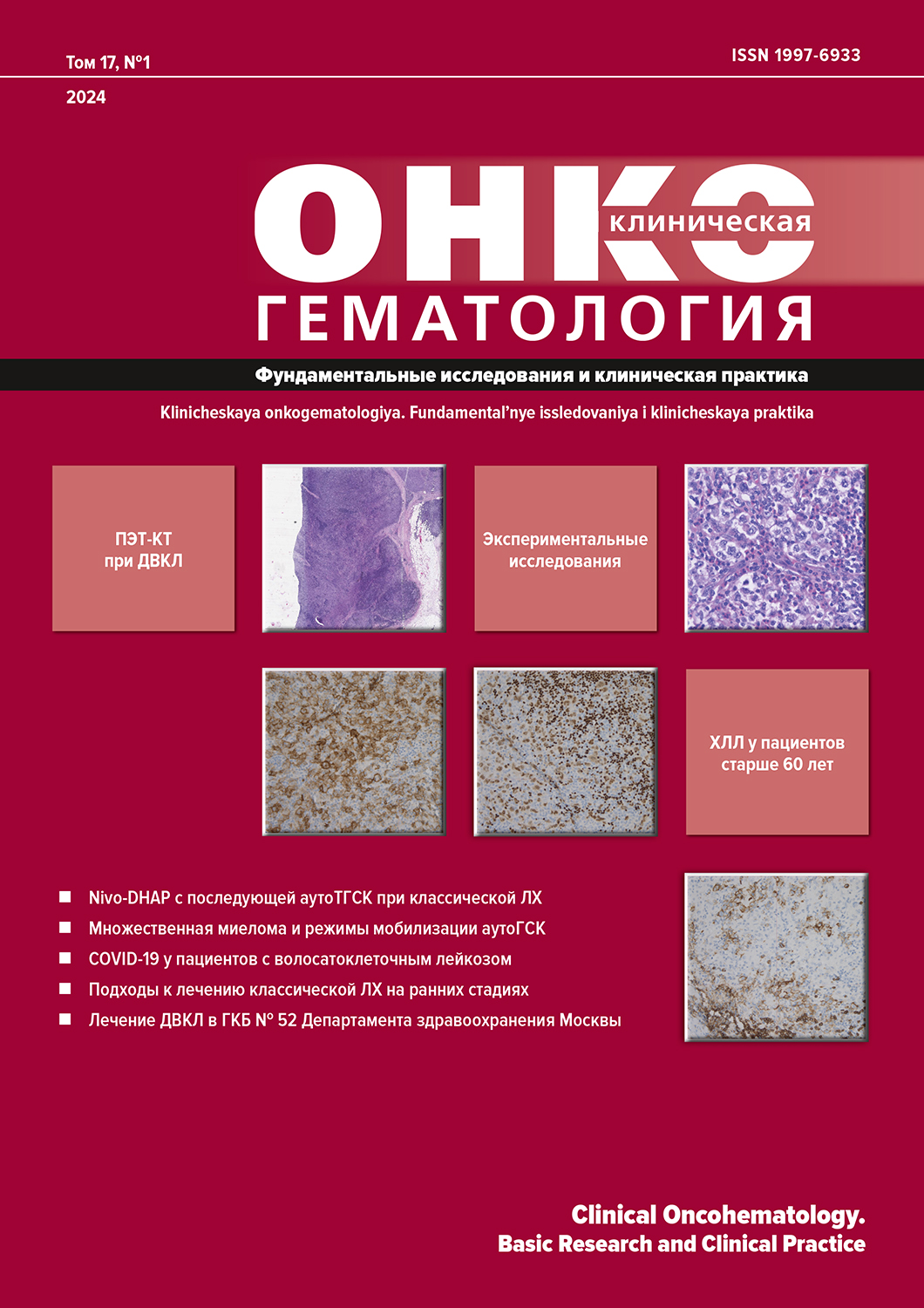Abstract
Aim. To assess the efficacy and tolerability of ibrutinib in chronic lymphocytic leukemia (CLL) therapy for high- and very-high-risk patients over 60 years of age.
Materials & Methods. The study enrolled 18 CLL patients aged 60 and older. The patients were stratified by age: group 1 included 10 patients aged 60–70 years (median age 64.5 years) and group 2 included 8 patients aged ≥ 71 years (median age 75.8 years); there was equal number of men and women. All patients were subjected to molecular genetic analysis to identify poor prognosis factors and determine the IGHV gene mutation status. The cytogenetic analysis revealed karyotypic abnormalities including 17p deletion in 3 female patients aged 60, 66, and 77 years, respectively. All the patients had CLL without mutation in IGHV genes. They received ibrutinib 420 mg/day per os as first- and second-line therapies.
Results. All patients showed aggravated comorbidity. The median follow-up was 28 months (range 18–42 months) in age group 1 and 46 months (range 12–78 months) in group 2. In group 1, a complete remission in 2 patients with del(17p) and a partial remission (PR) in 3 patients were achieved. PR with lymphocytosis was reported in the rest of 5 patients treated with ibrutinib for 12 months. In group 2, PR with the management of autoimmune complications in 5 out of 8 patients and PR with lymphocytosis in 3 patients were reported. The drug was well tolerated in both groups. No signs of severe hematological toxicity were observed in either of them.
Conclusion. The choice of ibrutinib for high- and very-high-risk CLL patients aged 60 and older appeared to be optimal. This is also proved by the ease of administration of oral capsules, high efficacy, absence of tumor lysis syndrome, good tolerability, and acceptable toxicity profile.
References
- Zenz T, Eichhorst B, Busch R, et al. TP53 mutation and survival in chronic lymphocytic leukemia. J Clin Oncol. 2010;28(29):4473–9. doi: 10.1200/JCO.2009.27.8762.
- Rossi D, Khiabanian H, Spina V, et al. Clinical impact of small TP53 mutated subclones in chronic lymphocytic leukemia. Blood. 2014;123(14):2139–47. doi: 10.1182/blood-2013-11-539726.
- Никитин Е.А., Судариков А.Б. Хронический лимфолейкоз высокого риска: история, определение, диагностика и лечение. Клиническая онкогематология. 2013;6(1):59–67. [Nikitin EA, Sudarikov AB. Highrisk chronic lymphocytic leukemia: history, definition, diagnosis, and management. Klinicheskaya onkogematologiya. 2013;6(1):59–67. (In Russ)]
- Fischer K, Bahlo J, Fink AM, et al. Long-term remissions after FCR chemoimmunotherapy in previously untreated patients with CLL: Updated results of the CLL8 trial. Blood. 2016;127(2):208–15. doi: 10.1182/blood-2015-06-651125.
- Wierda WG, Byrd JC, Abramson JS, et al. Chronic Lymphocytic Leukemia/Small Lymphocytic Lymphoma, Version 4.2020, NCCN Clinical Practice Guidelines in Oncology. J Natl Compr Canc Netw. 2020;18(2):185–217. doi: 10.6004/jnccn.2020.0006.
- Хронический лимфолейкоз. Современная диагностика и лечение. Руководство для клиницистов под ред. Е.А. Никитина. М., 2021. 436 с. [Nikitin EA, ed. Khronicheskii limfoleikoz. Sovremennaya diagnostika i lechenie. Rukovodstvo dlya klinitsistov. (Chronic lymphocytic leukemia. Current methods of diagnosis and treatment. A clinician’s manual.) Moscow; 2021. 436 p. (In Russ)]
- Hallek MJ, Cheson BD, Catovsky D, Caligaris-Cappio F. IwCLL guidelines for diagnosis, indications for treatment, response assessment, and supportive management of CLL. Blood. 2018;131(25):2745–60. doi: 10.1182/blood-2017-09-806398.
- Российские клинические рекомендации по диагностике и лечению лимфопролиферативных заболеваний. Под ред. И.В. Поддубной, В.Г. Савченко. М.: Буки Веди, 2018. С. 179–200. [Poddubnaya IV, Savchenko VG, eds. Rossiiskie klinicheskie rekomendatsii po diagnostike i lecheniyu limfoproliferativnykh zabolevanii. (Russian clinical guidelines on diagnosis and treatment of lymphoproliferative disorders.) Moscow: Buki Vedi Publ.; 2018. рp. 179–200. (In Russ)]
- Burger JA, Tedeschi A, Barr PM, et al. Ibrutinib as initial therapy for patients with chronic lymphocytic leukemia. N Engl J Med. 2015;373(25):2425–37. doi: 10.1056/NEJMoa1509388.
- Woyach JA, Ruppert AS, Heerema NA, et al. Ibrutinib Regimens versus Chemoimmunotherapy in Older Patients with Untreated CLL. N Engl J Med. 2018;379(26):2517–28. doi: 10.1056/NEJMoa1812836.
- Moreno C, Greil R, Demirkan F, et al. Ibrutinib plus obinutuzumab versus chlorambucil plus obinutuzumab in first-line treatment of chronic lymphocytic leukemia (iLLUMINATE): a multicentre, randomised, open-label, phase 3 trial. Lancet Oncol. 2019;20(1):43–56. doi: 10.1016/S1470-2045(18)30788-5.
- Munir T, Brown JR, O’Brien S, et al. Final analysis from RESONATE: Up to six years of follow-up on ibrutinib in patients with previously treated chronic lymphocytic leukemia or small lymphocytic lymphoma. Am J Hematol. 2019;94(12):1353–63. doi: 10.1002/ajh.25638.
- International CLL-IPI working group. An international prognostic index for patients with chronic lymphocytic leukaemia (CLL-IPI): a meta-analysis of individual patient data. Lancet Oncol. 2016;17(6):779–90. doi: 10.1016/S1470-2045(16)30029-8.
- Pflug N, Bahlo J, Shanafelt T, Eichhorst B. Development of a comprehensive prognostic index for patients with chronic lymphocytic leukemia. Blood. 2014;12(4):49–62. doi: 10.1182/blood-2014-02-556399.

This work is licensed under a Creative Commons Attribution-NonCommercial-ShareAlike 4.0 International License.
Copyright (c) 2023 Clinical Oncohematology
